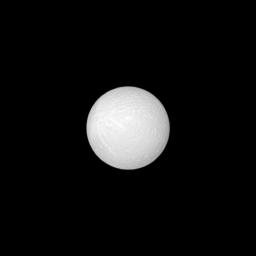
|
Where Have All the Shadows Gone?
- Click the image above for a larger view
- Full-Res JPEG (582 x 582) (8.2 kB)
- Full-Res TIFF (582 x 582) (339.3 kB)
Caption:
The Cassini spacecraft acquired this view of Rhea's leading hemisphere near "opposition," or with the Sun almost directly behind the camera.
Under this geometry, topography appears less rugged because crater rims and hills hide their own shadows. Consequently, in this view, the contrast between ejecta from Rhea's bright ray crater and the surrounding terrain is subdued, making the rays barely discernible. (Look towards the upper left hand side to see the rays.)
In this image, the brightest features are sunward-facing crater walls.
The image was taken in visible light with the Cassini spacecraft narrow-angle camera on Aug. 29, 2008 at a distance of approximately 1.346 million kilometers (836,000 miles) from Rhea and at a Sun-Rhea-spacecraft, or phase, angle of about 1 degree. Image scale is 8 kilometers (5 miles) per pixel.
Background Info:
The Cassini-Huygens mission is a cooperative project of NASA, the European Space Agency and the Italian Space Agency. The Jet Propulsion Laboratory, a division of the California Institute of Technology in Pasadena, manages the mission for NASA's Science Mission Directorate, Washington, D.C. The Cassini orbiter and its two onboard cameras were designed, developed and assembled at JPL. The imaging operations center is based at the Space Science Institute in Boulder, Colo.
For more information about the Cassini-Huygens mission visit http://saturn.jpl.nasa.gov/ . The Cassini imaging team homepage is at http://ciclops.org .
Cataloging Keywords:
| Name | Value | Additional Values |
|---|---|---|
| Target | Rhea | |
| System | Saturn | |
| Target Type | Satellite | |
| Mission | Cassini-Huygens | |
| Instrument Host | Cassini Orbiter | |
| Host Type | Orbiter | |
| Instrument | Imaging Science Subsystem (ISS) | |
| Detector | Narrow Angle Camera | |
| Extra Keywords | Crater, Grayscale, Shadow, Visual | |
| Acquisition Date | ||
| Release Date | 2008-12-25 | |
| Date in Caption | 2008-08-29 | |
| Image Credit | NASA/JPL/Space Science Institute | |
| Source | photojournal.jpl.nasa.gov/catalog/PIA10542 | |
| Identifier | PIA10542 | |
